| 1 | Golden tree snake |
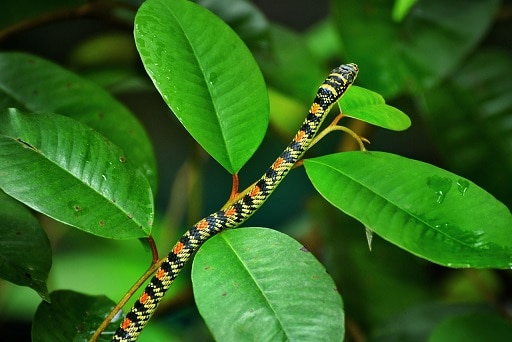
Among 3900 snakes, the golden tree snake may be the most likely to randomly land on your head. This is a flying species, and with their constant mad attempts to glide towards geckos they’ve just spotted, without considering the risks, there’s a great chance to misjudge the angles and land on a villager’s face.
Golden tree snakes measure 100-130cm, and inhabit most of Thailand. According to this Thai snake expert, they’re the country’s most frequently sighted snake. Chrysopelea ornata is a familiar character in villages and public parks, and a love of thin tree branches already increases their chances of falling on people. This species can cross the thinnest, most spidery branches, which they nimbly navigate. Then there’s a tendency to stash themselves in dark attics, or even bathrooms. Chrysopelea ornata is just as happy on manmade roofs as tree canopies. They’re also fast and energetic, with low inhibitions.
All this gives this species a high chance of plummeting onto your scalp, your hat, or even your face if you instinctively sense something and look up at the last millisecond. While golden tree snakes have a mild venom, they’ve never caused a serious injury in humans.
| 2 | Gopher snakes |
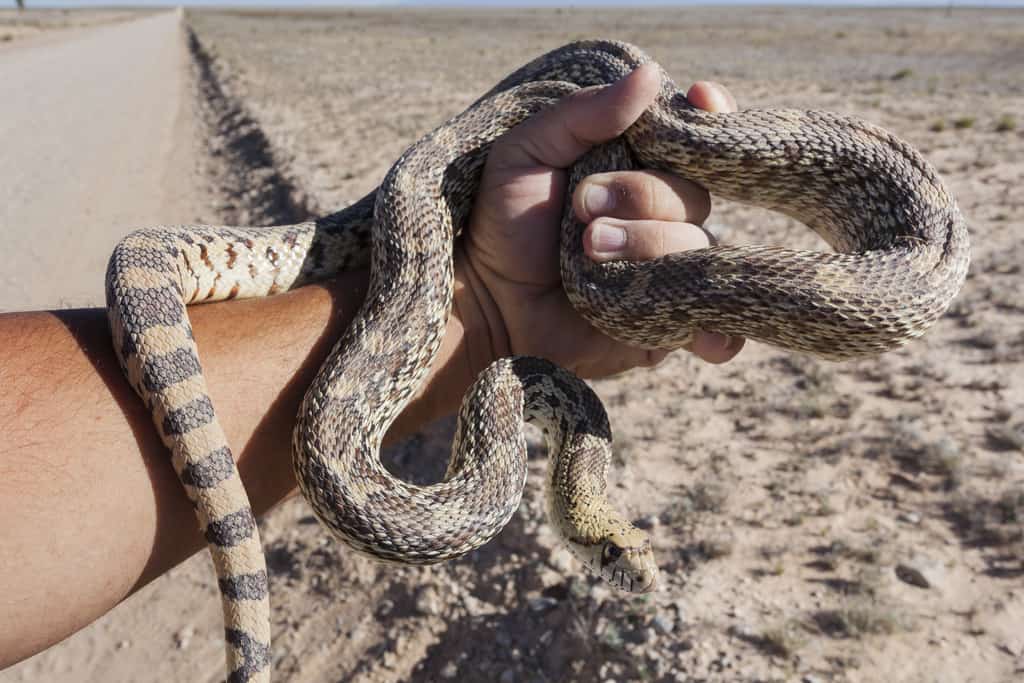
There’s a definite chance that you’ll be fishing peacefully on a river shore, watching the shadows change angles over the hours, before a gopher snake randomly lands on your head. The reason: this snake is popular prey for the US’s many predatory birds.
Gopher snakes are non-venomous and regularly exceed 2 metres. Over 80% of their diet is mammals, and they occupy the entire western half of the USA. According to a study along the Columbia river in Washington state, 18% of the red-tailed hawk’s diet was the gopher snake. In a study from California’s San Joaquin, gopher snakes were eaten by red-tailed hawks 225 times, while rattlesnakes were eaten 83 times. Something about them just tastes fantastic, and since they won’t accept their fate meekly, a gopher snake can easily break free from a bird’s clutches in mid-air, just as the hawk is celebrating mentally. Thus they come in contact with a blissfully relaxed fisherman, startling him and possibly knocking his hat off.
Seeing as the Colombia river is proven to be a gopher snake-hawk battleground, you should exercise extreme caution there. But any open area in California, Oregon, etc could be home to gopher snakes plummeting from the sky.
| 3 | Ball python |
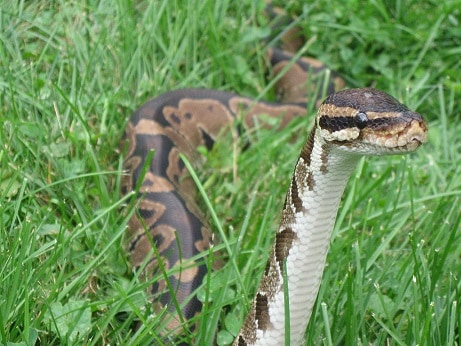
Ball pythons are an abundant species in Nigeria, Ghana and Togo, particularly on farmland. They were long assumed to eat mammals, and they mostly do, swallowing up rodents for farmers who commonly worship them as deities. However, it turns out that ball pythons have a large gender split: females ate 67.7% mammals, while males ate 70.2% birds. This means that males are found in trees much more commonly, and it also makes them highly likely to land on your head, whether you’re a hardworking cocoa farmer or an overexcited tourist flashing a camera.
Like the black ratsnake, ball pythons are merely decent climbers. They ascend trunks just fine, but they don’t cling to thinner branches as deftly as a Blanding’s catsnake (also found in Nigeria). Ball pythons don’t have immense evolutionary pressure on their side; they don’t have the forces of survival compelling them to become thinner, nimbler and twitchier.
Consequently, ball pythons are likely to dislodge, fall through mid-air and land on your unsuspecting head. This won’t hurt you, and probably not the ball python, but that said, most people don’t expect a serpent to land on their head when they wake up that morning. Ball pythons are totally harmless and docile, and average at 100cm.
| 4 | Orange-bellied glasstail |
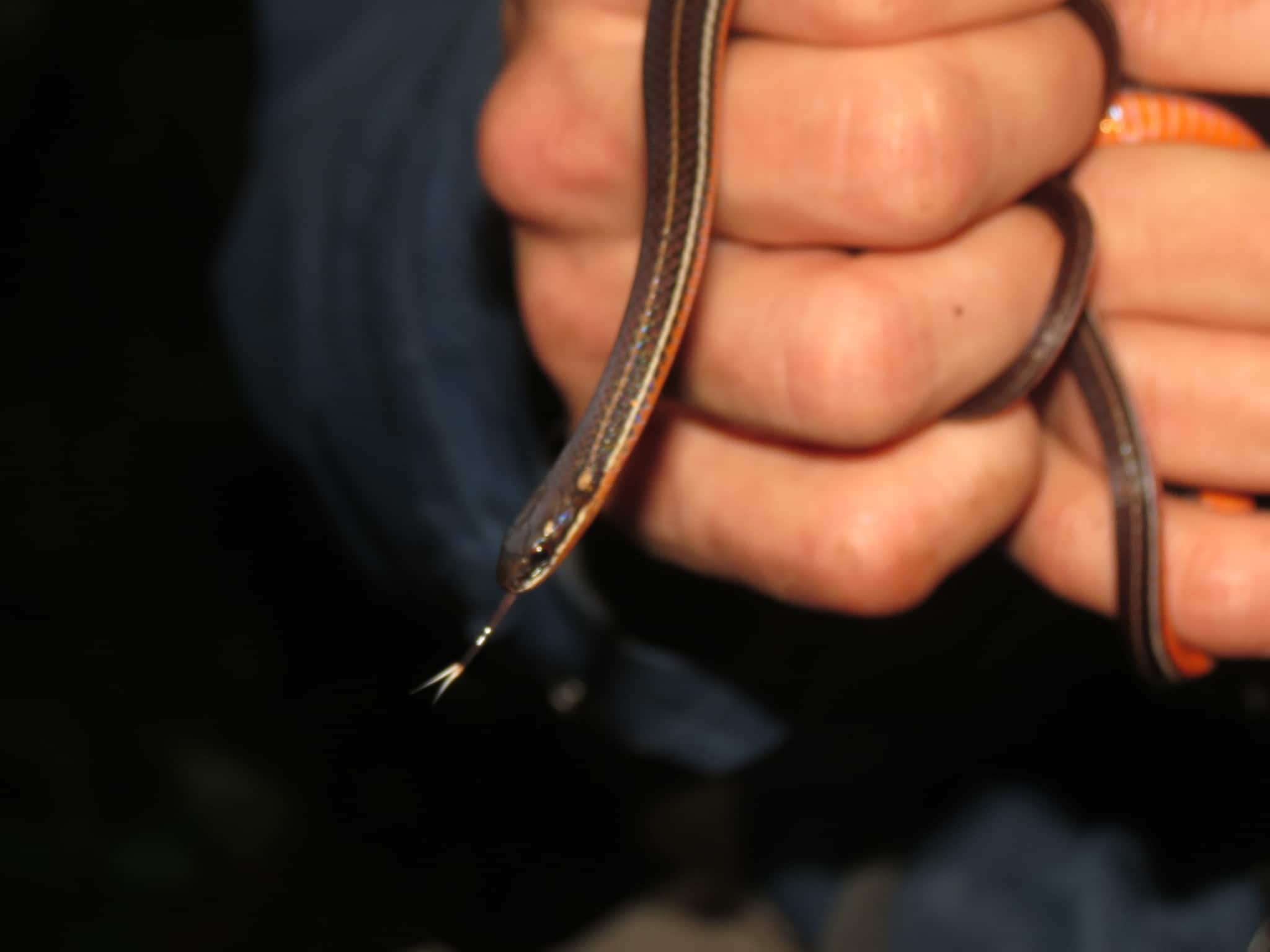
A Costa Rican forest snake, also found in Panama. At 30-40cm, this snake won’t cause a dent in your skull, but could send a jolt of panic through your body like electricity. Orange-bellied glasstails appear in the deepest sections of forests, mainly sticking to the ground. Like gopher snakes, it’s because of birds that they’re able to land on your head. This is irresistible bird prey for a hawk or eagle, and once spotted, they can swoop down in seconds.
Despite being tinier, this is trickier prey for a bird than the gopher snake. Orange-bellied glasstails are actually more likely to land on your head, as their glasstail name refers to their skill of caudal autonomy, detaching their own tail to escape from predator’s clutches.
Many orange-bellied glasstails in the wild have missing tails. All you have to be is directly below the place it plummets to, and an orange rainforest snake will land on your face. The bird might be celebrating, only to find that their talons contain nothing, or just a hard scaly appendage. There’s no need to kill the orange-bellied glasstail out of fear, as they’re completely harmless.
| 5 | Chilean long-tailed snake |
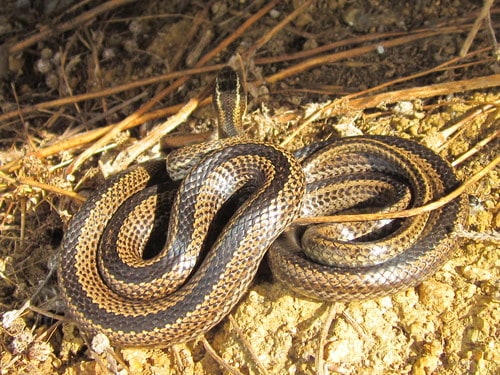
Chile’s most commonly encountered snake, in a surprisingly barren serpent nation of just 7 species. Chilean-longed tail snakes measure 140cm and are fast and inquisitive. You can find them all over – on bridges across forest streams, scrabbling over kitchen tiles, hiding under a park bench, and falling from above with no explanation.
Chilean-longed tail snakes also eat a varied diet, and it’s their bird’s nest raids which give them the power to drop on your head. A 1992 study found a diet of 17/38 lizards, 14/38 frogs and toads, 3/38 mammals and 3/38 birds, making for a nice side meal. Philodyras chamissonis has been spotted swallowing the thorn-tailed rayaito, and can reach 5.5 metres high. Like with any hungry snake, the birds don’t accept their fate lying down. They’ll squawk and flap until Philodyras chamissonis gives up, sometimes sending it plummeting to the forest floor, or the garden floor, or a public park where old ladies are enjoying a catch up chat.
Overall, the Chilean-long tailed racer is a snake which lacks inhibitions, which will take on any challenge without considering the risks, even if it ends with them landing on a human’s head.
| 6 | Reticulated python |
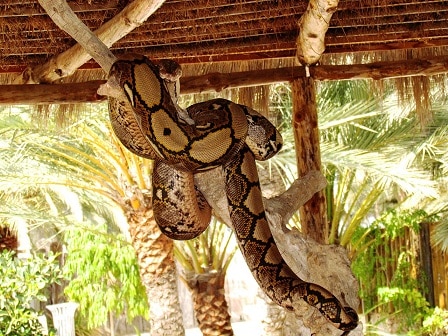
If this giga python plummets onto your head, there’s no way that you won’t know about it. Reticulated pythons are the world’s largest snake, but much more of a climber than you’d expect. They’re an inquisitive, curious snake which often gets drawn onto roof rafters, lampposts and archways for inexplicable reasons. They can drape themselves around a wooden roof for hours, which in turn means dozens of people having to tiptoe beneath them.
Reticulated pythons are common in urban zones like Singapore, and being crushed by one is probably a greater risk than being eaten. Reticulated pythons range from Thailand to Java, and the largest of all time measured 7.67 metres. Their weight can exceed 200 pounds, making them a rare snake to be heavier than a human.
All this makes walking beneath a reticulated python like shown above very intense. If you spook them, they could dislodge and plummet down. Alternatively, this could be a calm individual which doesn’t let insignificant, irrelevant creatures like humans bother it. Despite being so huge they look like they’d bring the roof down, reticulated pythons have a secure grip. Whether they crush your skull depends on what decision they make.
| 7 | Beauty ratsnake |
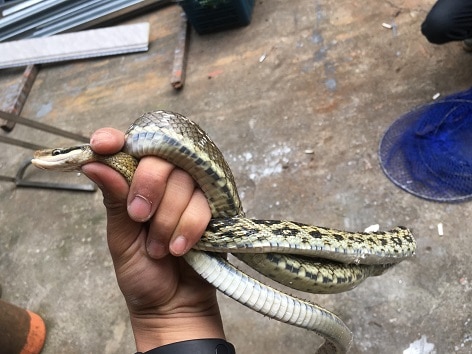
Beauty ratsnakes are one of the classic building climbers, grinding up brick walls and disappearing into dark roofs. This time, they have a purpose, to find mice lurking there, plus a cool place to shelter. Beauty ratsnakes are abundant in the green villages of southern China, thus making this a likely place for a snake to land on your head.
Though able to slither up vertical walls, beauty ratsnakes aren’t infalliable, and may lose their grip on a roof and plummet straight to the ground. Their next destination is a farmer’s head, knocking off his precious hat. Luckily, beauty ratsnakes barely weigh more than a few pounds. Nor are they venomous, but they do have an aggressive temperament, readily deploying their sharp teeth, which are capable of drawing blood and leaving no illusion of a peaceful local guardian serpent. A close encounter with a beauty ratsnake is survivable, yet potentially painful.
Farmers, villagers, postmen, even the local mayor have a high chance of a beauty ratsnake landing on their head. Beauty ratsnakes live in fields, margins of agricultural areas, woodlands, and of course villages. There’s also a cave-dwelling subspecies, Ridley’s cave racer, which can slither up the stone walls and drop on your head from another angle.
| 8 | Brown watersnake |
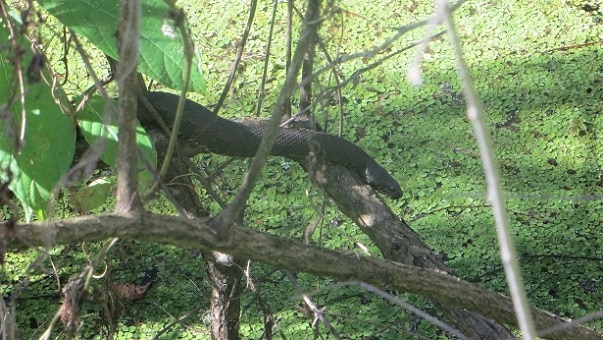
The brown watersnake is a classic snake for dropping from tree branches, because this is its main response when spooked. This could be on your head, if you’re unlucky enough to be directly below. Brown watersnakes live in southern US states like Louisiana and Alabama, and favour swamps, lakes and wider rivers alike. They’re darker than the northern watersnake and lack venom, and get 60% of their meals from crayfish.
Brown watersnakes love to drape themselves on branches by the shore, basking in the sun. Because they lack defensive weapons, their first instinct is to detach from a tree branch when predators approach, either dropping into the river or nearby dry land. Hence, brown watersnakes could give a fisherman the shock of a lifetime, possibly the same fisherman who just abandoned Washington state because of the gopher snakes dropping onto his head.
It’s somewhat counterproductive, as they drop down to escape threats, but may actually end up closer to them. The reaction is purely instinctive: shock and surprise cause their muscles to slacken, and therefore lose their grip. It’s completely automatic. They may of course be leaping at you – we can’t read their mind.
| 9 | Grass snake |
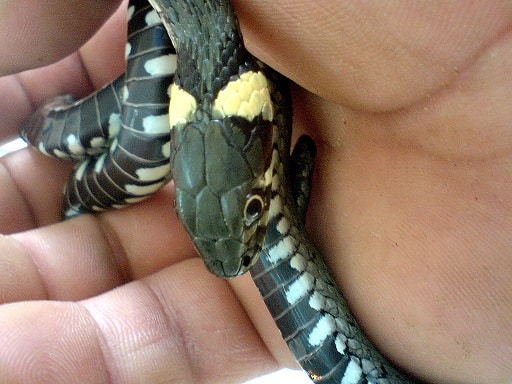
Grass snakes live in ponds, streams, and fields of the southern British shires, and almost never climb trees. Nor do they climb walls and enter roofs. But they still have the power to land on an innocent person’s head, once again due to hungry birds.
Chris Tredwell was a 75 year old dog walker enjoying a stroll through Hartshole County Park in 2020. Looking up, he saw a black crow carrying what he thought was a twig. But it was actually a grass snake, as he discovered when it landed at his feed, barely missing his head. The grass snake moved slightly, startling the dog. Whether the grass snake had escaped or the overencumbered bird had released it was never established.
Grass snakes are completely harmless, with no dangerous venom and never biting. However, they’ll still thrash free of a predator’s talons. There’s no harm if they land on you, even if they’re draped around your face like a piece of spaghetti, But they do have a tendency to release a foul serpent smell when frightened. The unluckiest dog walker in Britain could be treated to this the exact moment the grass snake collides with him.
| 10 | Western ratsnake |
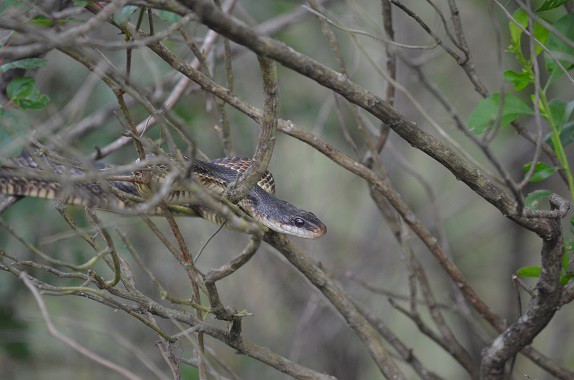
Western ratsnakes are a common species west of the Mississippi river, which lack venom and kill their prey via constriction. They measure 100-180cm, and move steadily and patiently. Birds make up 20-42% of the black ratsnake’s diet (study), and they regularly raid nests directly.
While western ratsnakes climb tree trunks with aplomb, they’re less secure on branches than they’d like to be. They don’t coil around a tree’s limbs, instead balancing more like a tightrope walker. If they mess with the wrong bird’s nest, the furious mother could arrive in seconds, and assault the snake in a flurry of squawking and feathers. One sharp peck will send the western ratsnake plummeting to the ground, possibly onto the head of a horrified child about to climb the tree in order to impress his mates.
Western ratsnakes are a great candidate for plummeting to the floor and randomly colliding with people, whether an elk hunter or a dog walker. Their risky hunting methods have a good chance of going horribly wrong and knocking them off a precarious branch. If a bird is furious enough, then the western ratsnake may even leap off on purpose, in desperation.
